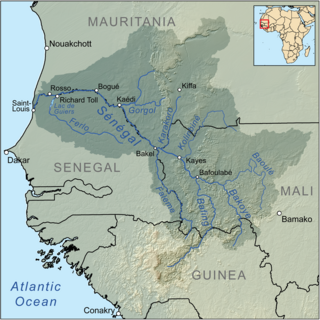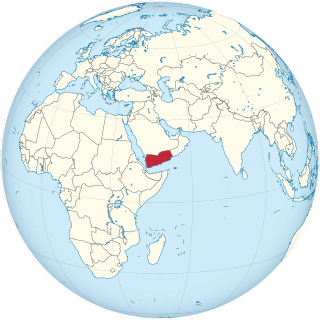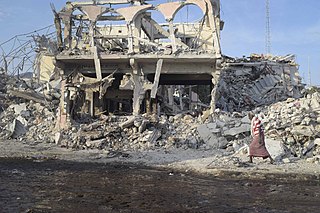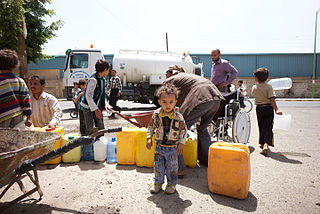It has been requested that the title of this article be changed to 2017 Somali drought . Please see the relevant discussion on the discussion page. The page should not be moved unless the discussion is closed; summarizing the consensus achieved in support of the move. |

As of February 2017 a drought ravages Somalia that has left more than 6 million people, or half the country's population, facing food shortages with several water supplies becoming undrinkable due to the possibility of infection. [1]

Somalia, officially the Federal Republic of Somalia (Somali: Jamhuuriyadda Federaalka Soomaaliya; Arabic: جمهورية الصومال الفيدرالية, translit. Jumhūrīyah aṣ-Ṣūmāl al-Fīdirālīyah, is a country with its territory located in the Horn of Africa. It is bordered by Ethiopia to the west, Djibouti to the northwest, the Gulf of Aden to the north, the Guardafui Channel and Somali Sea to the east, and Kenya to the southwest. It is separated from Socotra by the Guardafui Channel in the northeast and from the Seychelles by the Somali Sea. Somalia has the longest coastline on Africa's mainland, and its terrain consists mainly of plateaus, plains and highlands. Climatically, hot conditions prevail year-round, with periodic monsoon winds and irregular rainfall.
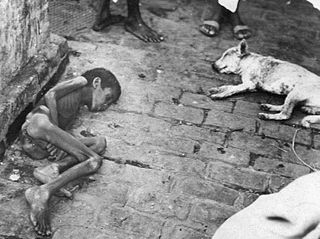
A famine is a widespread scarcity of food, caused by several factors including war, inflation, crop failure, population imbalance, or government policies. This phenomenon is usually accompanied or followed by regional malnutrition, starvation, epidemic, and increased mortality. Every inhabited continent in the world has experienced a period of famine throughout history. In the 19th and 20th century, it was generally Southeast and South Asia, as well as Eastern and Central Europe that suffered the most deaths from famine. The numbers dying from famine began to fall sharply from the 2000s.
Contents
- Causes
- Humanitarian situation
- Calls for response
- Immediate response
- Adequate response
- Response
- Government response
- Germany
- International
- See also
- References
- External links
According to the Humanitarian Information Unit of the U.S. Government, over 2.9 million people in Somalia face crisis or emergency level acute food insecurity and need emergency food aid, as a result of below average to failed rains in many areas in 2016 that reduced crop production and harmed livestock. Somalia is currently facing its seventh consecutively poor harvest and food stability is a major issue. In the April-June rainy season little to no rainfall occurred across much of Somalia in April, but rain has begun and is forecasted in May. Lack of potable water has accelerated an acute watery diarrhea-cholera outbreak with an estimated 32,000 cases reported since the beginning of the year. 1.4 million children are projected to need treatment for acute malnutrition in 2017, according to the UN Children's Fund (UNICEF). FEWS NET expects 2.9 million people will remain in crisis and emergency levels of acute food insecurity through at least June 2017. In March 2017, 1.75 million people received international food assistance, according to the UN Office for the Coordination of Humanitarian Affairs (OCHA). [2]

Diarrhea is the condition of having at least three loose, liquid, or watery bowel movements each day. It often lasts for a few days and can result in dehydration due to fluid loss. Signs of dehydration often begin with loss of the normal stretchiness of the skin and irritable behaviour. This can progress to decreased urination, loss of skin color, a fast heart rate, and a decrease in responsiveness as it becomes more severe. Loose but non-watery stools in babies who are exclusively breastfed, however, are normal.

Cholera is an infection of the small intestine by some strains of the bacterium Vibrio cholerae. Symptoms may range from none, to mild, to severe. The classic symptom is large amounts of watery diarrhea that lasts a few days. Vomiting and muscle cramps may also occur. Diarrhea can be so severe that it leads within hours to severe dehydration and electrolyte imbalance. This may result in sunken eyes, cold skin, decreased skin elasticity, and wrinkling of the hands and feet. Dehydration can cause the skin to turn bluish. Symptoms start two hours to five days after exposure.

Malnutrition is a condition that results from eating a diet in which one or more nutrients are either not enough or are too much such that the diet causes health problems. It may involve calories, protein, carbohydrates, vitamins or minerals. Not enough nutrients is called undernutrition or undernourishment while too much is called overnutrition. Malnutrition is often used to specifically refer to undernutrition where an individual is not getting enough calories, protein, or micronutrients. If undernutrition occurs during pregnancy, or before two years of age, it may result in permanent problems with physical and mental development. Extreme undernourishment, known as starvation, may have symptoms that include: a short height, thin body, very poor energy levels, and swollen legs and abdomen. People also often get infections and are frequently cold. The symptoms of micronutrient deficiencies depend on the micronutrient that is lacking.
An estimated 1.1 million IDPs currently live in Somalia, and at least 548,000 additional people have been displaced since November 2016 due to the drought. Most people displaced by drought left rural parts of Bay, Lower Shabelle, and Sool and settled in urban areas such as Mogadishu and Baidoa. Displacement numbers continue to rise as more people leave their homes and displacement monitoring increases. IOM and other UN agencies estimate that the number of IDPs, a highly vulnerable group in Somalia, will rise to 3 million by June if the April-June rains are below average or fail entirely. Additionally, since January 2016, about 56,000 former Somali refugees have returned from Kenya's Dadaab refugee camp to Somalia through UNHCR's voluntary repatriation program and have settled in Gedo, Bay, Lower Jubba, and Banaadir. [2]

An internally displaced person (IDP) is someone who is forced to flee his or her home but who remains within his or her country's borders. They are often referred to as refugees, although they do not fall within the legal definitions of a refugee.

Bay is an administrative region (gobol) in southern Somalia.

Lower Shabelle is an administrative region (gobol) in southern Somalia.






